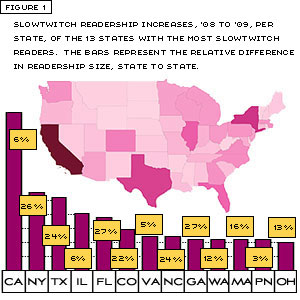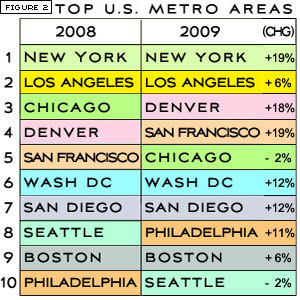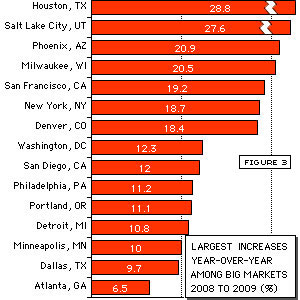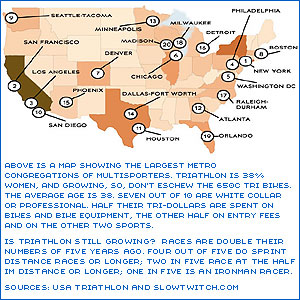Where do triathletes live?

What follows is the result of an analysis of Slowtwitch reader trends—not an analysis of what you want to read, or what you read, or who you are, or your age or sex or what sort of races you do. Rather, where you're from. Just that.
To that end, may I be permitted two paragraphs of background?
What seemed to me a century ago Lew Kidder and I submitted a new set of bylaws for a vote of USA Triathlon's members. We did so because Lew and I tired of the inequities and imbalances of power inherent in federation governance. We were able to do this because Lew is master parliamentarian. We were successful in doing this because most of you who voted agreed with our assessment the the federation's bylaws needed an overhaul.
The hallmark of those new bylaws was an entirely new set of voting districts based on a census of the membership—eight districts, the least populated of which contained a population no less than about 75% of the largest district.
In fact, this didn't take place a century ago, or a decade ago, it all took place less than 6 years ago. I got to wondering how the demographics of triathlon have shifted since then. Frankly, my interest has to nothing to do with federation politics, rather whether the business sector of our sport is keeping up with you movers and shakers out there.
For example, if your region has seen a big increase in the number of triathletes, has industry kept track? Are there enough races to service your new numbers? Enough retail stores? Are the sales rep territories that the manufacturers might have set up a long time ago current today? Do the manufacturers know when a metro area can support another retailer?
When Lew and I were divvying you all up into voting regions, we had to wrestle with this fact: California, Texas, and Florida were the "big three." The population of triathletes in these states overwhelmed all the others. (This is why, back when the USAT voting regions were simply East, Central and West, most the board members came from these three states!)
Boy, have things changed. I thought I'd take a look and see how much they've changed, and, share it with you.
But let me state a caveat: The following is based on Slowtwitch readership patterns. These may or may not be reflective of the triathlon population across America. I suspect Slowtwitch is a pretty good proxy for triathlon demographics in the U.S., but, maybe not. Please bear this in mind.
STATES WITH THE MOST TRIATHLETES
No longer, if Slowtwitchery is reflective of actual tri demographics, are the Big-3 states CA, TX and FL. In fact, Florida is now #5, and New York has come from nowhere over the past 5 years to become the second most populous state among Slowtwitchers. This is no surprise to us. We served almost 50,000 page views when we covered the NYC Triathlon live last year, although 5,500 of our prospective New York readers were competing in the race instead of reading our coverage, and another 2,500 New Yorkers were up the road on the same day racing Ironman Lake Placid. Since the race started at 2:50 a.m., West Coast time, who were these folks interested in the New York racing scene? Not West Coasters! Yet more New Yorkers, apparently.
FIGURE 1 above shows the 13 states containing the largest population of Slowtwitchers, and, we served 6% more pages to Californians during '09 than we did in '08. You'll note that we served 26% more pages to New Yorkers, however, during that time span. This doesn't mean that there are 26% more triathletes in New York year-over-year, just that we served that many more pages. The point is that, for us, New York is a much faster growing market than California is, even though California is by far the state with the most Slowtwitch readers. It is our guess that this more or less reflects the incremental growth of triathlon's numbers in New York relative to other areas.
Note the growth in our readership from Texas, Colorado, and the Deep South (including the Carolinas, Georgia, Florida). More about that later.

TOP METRO AREAS
In FIGURE 2 we've normalized these percentages for our year-over-year growth in readership, just to see the shift in where our readers are coming from. New York City, considered as a metro area (which would take in Westchester County, Northern New Jersey, Long Island, perhaps some of Connecticut), is the largest metro concentration of Slowtwitchers. It also became larger yet in 2009 versus 2008, as it grew by 19% for us relative to our overall readership.
Denver is not far behind, however, in its growth rate. San Francisco is growing (for us) faster than L.A. and San Diego. While we had more Chicago readers in 2009 than in 2008, Chicago's piece of the Slowtwitch readership pie fell slightly.
In general, readers from the larger metro areas became a larger part of our readership. But not across the board. Philly grew by 12%, adjusted for our year-over-year growth (it actually grew in real pages served by 20%); this, while—even in a growth year for Slowtwitch—the number of page views we served to Pittsburgh fell by 24% (and adjacent West Virginia's page views fell by half). So, while we served about 3% more pages to Slowtwitchers in Pennsylvania in 09 than we did in 08, we enjoyed big increases in the Eastern part of the state, but took a whalloping out West.
THE LARGE MARKETS WITH THE LARGEST INCREASES
If you consider large markets—and by this we'll narrow it down to the largest 25 metro areas in America—which are the up-and-comers, and what of the others?
Houston wins. Or to put it another way, Slowtwitch seems to be winning in Houston. That market grew for us by almost 28% according to one metric, and 31% according to another. In fact, while Dallas has historically always been a larger tri market than Houston, that appears no longer to be the case. Yes, Dallas continues to grow its number of triathletes, but, not at Houston's pace. Our Houston readership first outstripped our Dallas readership about two years ago, and now Houston is our 12th largest metro area in terms of Slowtwitchers, while Dallas is now number-14. We serve about 135 pages to metro Houston readers for every 100 we serve to Dallas-Fort Worth readers.

And that's just the way it is in Texas. Every Texas metro area is up for us, and, as a state, readership is up 24% year-over-year.
There appear to us to be three big regions of growth in triathlon. First, the Deep South, and, while Texans probably don't consider their state part of the Deep South proper, there seems to be a growth trend throughout the Gulf States. Texas, Louisiana, Alabama, Georgia and Florida are way up for us. Once you get away from the Gulf, it's less so. Slowtwitch readership in Tennessee is flat, likewise in Kentucky, though it's up healthy in Louisville, no doubt because of the presence of an Ironman.
The other large area of growth is the Northeast Corridor. From Washington DC (up 16%), through Maryland (up 16%), metro Philly, NYC, the rest of New York State, Connecticut (up 30%), Vermont (up 77%), New Hampshire (up 39%), Maine (up 21%), and Massachussets (up 16%), this is where a lot of Slowtwitchers call home.
Finally, it seems that mountain states are, in the aggregate, growth areas. Colorado is now the sixth most populous state in terms of Slowtwitchers, and becomes, in a way, the "new Ohio" (a state that has historically been a hotbed of triathlon but, perhaps, may be less so now than it was?). And, then, Utah (up 31%). No, Utah is no triathlon juggernaut. But neither is it a triathlon desert any longer. It used to be. Utah was nowheresville in triathlon a half-dozen years ago. Then, somebody stuck an Ironman there. Even though it only lasted two years, it was enough to plant the seed. Utah has had a thriving little community of triathletes since then, and, it sits exactly in the middle of Slowtwitch readership, 25th out of 50 states. (And, it has its Ironman back.)
We lost readers in both Hawaii and Alaska. We were flat on Montana and in Idaho, New Mexico and Nevada (we gained well in Reno but lost in Las Vegas). In general, we lost readers, or had flat growth year-over-year, in rural areas and in rural states. We gained in populated areas. There were some areas of inexplicable demographic change: we were flat or slightly down in Tucson, Arizona, but way up in metro Phoenix. We were flat or down in Tampa, but way up in Florida as a whole.
This is a snapshot of our readership, as it is at the commencement of a new decade. Slowtwitchery can only be leveraged so far, and, it would be good to pair up this data with that from USA Triathlon, or other organizations. We derived our data above using metrics generated from Google Analytics and our own metric measuring software.
ANALYSIS AND PROGNOSIS
I will hazard some guesses, going forward: that the areas of double digit growth in our readership and, probably, triathlon in general, will continue to be the areas that have large population bases. Further to that—and this flies in the face of my former ambivalence to big-city races—it seems to clear to me that a downtown race increases numbers of triathletes in these large metro areas: rather than large triathlon populations spawning big city races, NYC and Washington DC show that big city races spawn ever larger numbers of triathletes (but I probably should have known that from Chicago and Minneapolis).
I think the economic woes of the past two years have impacted triathlon, but, the impact has fallen hardest on rural areas, and on rust belt and smokestack-based economies. Areas with high unemployment and foreclosure rates—like Las Vegas—have also taken a hit. Lots of Slowtwitchers read from work, and, where there's no work, there's less Slowtwitch to be read.
Now, to circle back on that set of bylaws Lew and I wrote. Great populists that we were (and still fancy ourselves), there was a clause in those bylaws that stated more or less as follows: When a voting region falls to a membership population half that of the largest region, the Board of Directors must remedy the imbalance. It would not surprise me to find that this clause has been triggered; and, it would surprise me if anyone noticed, cared, or has shown any interest in the matter. In any case, it is of no import to me. Politics is, like ITU racing, a younger man's sport.
My interest, as stated earlier, is to provide a tool for industry. Are bike manufacturers trying to wrench too much growth out of Chicago or Los Angeles when the bigger growth will come from Denver, Boston, and New York? Is Ironman crazy like a fox when it puts its new 70.3 pro nationals just outside of metro-Houston? And when it bought a Colorado-based set of races, one of which just sold out for 2010 almost immediately after opening for registration?
Ought Jeff Henderson to expand his calendar of races in Upstate New York to include Son-of-Musselman, and Day of the Mussel?
That established, to industry I say this: The above is one tool. Let us hope USAT, Active.com, and others come forward with stats that either confirm or contradict our own numbers.



